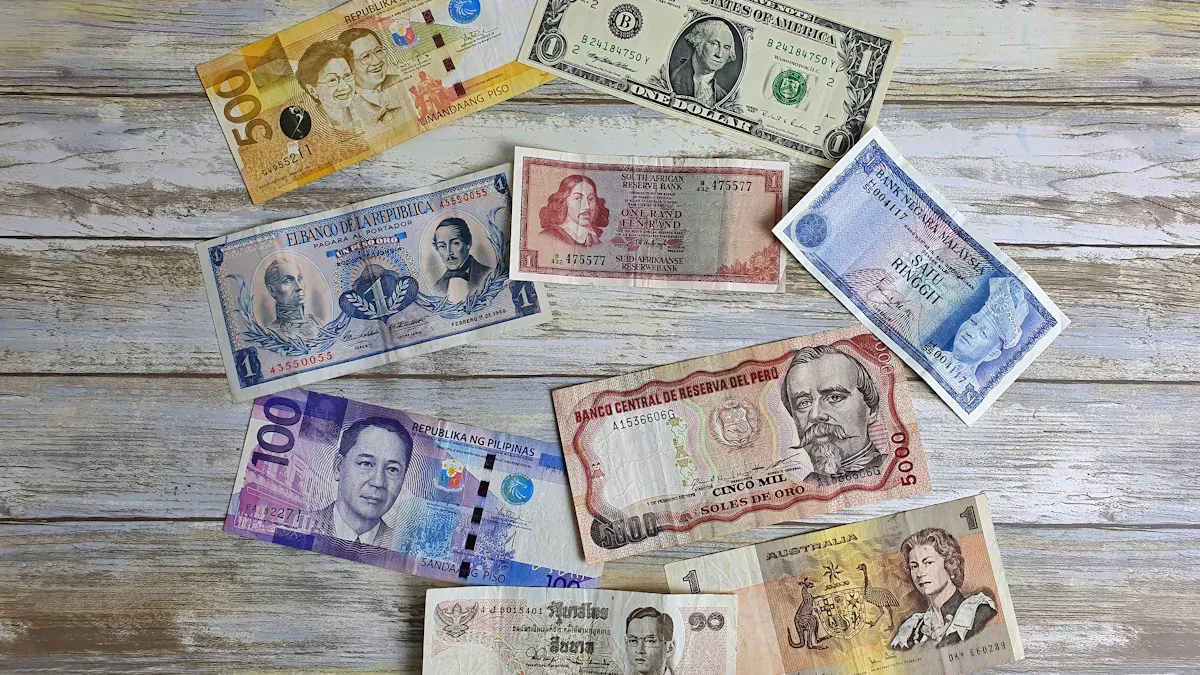- EasyCard
- Trade
- Help
- Announcement
- Academy
- SWIFT Code
- Iban Number
- Referral
- Customer Service
- Blog
- Creator
What You Need When Remitting Money from the United States to South Korea and How to Transfer Funds Quickly and Securely

Image Source: pexels
Are you planning to send money from the US to Korea through remittance? The key to a fast and secure transfer lies in preparing the necessary information in advance.
A successful transfer begins with thorough preparation. You need to gather three types of critical information:
- Recipient’s personal information
- Recipient’s bank account information
- Your own sender information
Having these materials ready is the first step to completing your transfer smoothly.
Key Points
- Before sending money, you need to prepare the recipient’s name, bank account number, and SWIFT code, as well as your own identity information.
- Online remittance platforms are typically faster, cheaper, and offer better exchange rates than traditional banks.
- Traditional bank wire transfers are suitable for large amounts but are expensive and slow.
- After choosing a transfer method, you need to register with the platform, enter information, complete identity verification, pay, and track the transfer.
- Before making a payment, carefully verify the recipient’s name and bank account details to ensure the funds arrive safely.
Essential Information Checklist for Transfers
To ensure your funds reach the recipient accurately, carefully verify and prepare the following three types of information before sending. This is like preparing a precise “map” for your funds to reach their destination smoothly.
Recipient’s Personal Information
Accurate personal information is the first step to a successful receipt. You need to obtain the following details from the recipient:
- Legal Full Name: Ensure the recipient’s name matches the legal name on their bank account exactly; any spelling errors could lead to transfer failure or delays.
- Korean Phone Number: Banks or remittance platforms may send receipt notifications via SMS.
- Email Address: Used to receive electronic receipts and transfer status updates.
- Full Residential Address: Including city, province, and postal code.
Recipient’s Bank Account Information
This is the core information for directing funds, so double-check carefully.
- Bank Name: For example, Woori Bank or Shinhan Bank.
- Account Number: The recipient’s local Korean bank account number.
- Bank SWIFT/BIC Code: This is the “address” for international transfers, ensuring your funds reach the correct bank.
Important Note: SWIFT/BIC codes typically consist of 8 or 11 characters. Ask the recipient to check with their bank or find the code on the bank’s website. Entering it incorrectly will directly cause the transfer to fail.
Sender’s Personal Information
To comply with anti-money laundering regulations, you also need to provide your own information to complete the transaction.
- Your Legal Full Name
- Your Residential Address in the US
- Social Security Number (SSN) or Individual Taxpayer Identification Number (ITIN)
- Contact Information (Phone and Email)
- Your Occupation
If you plan to send a large transfer (typically transactions exceeding $10,000), financial institutions may require additional documents to comply with U.S. financial regulations. You may need to prepare:
- Proof of funds source (e.g., pay stubs, sales contracts)
- Proof of wealth (explaining your income source)
- Detailed reason for the transfer
Preparing these documents in advance can make large transfers smoother.
Comparison of Mainstream Remittance Methods

Image Source: unsplash
Once you have all the information ready, the next step is to choose the right remittance method. Currently, there are two main ways to send money from the US to Korea: modern online remittance platforms and traditional bank wire transfers.
Each method has its pros and cons, and your best choice depends on your needs for speed, cost, and convenience.
Online Remittance Platforms
For most everyday remittances, online platforms are the better choice. They typically offer faster speeds, lower fees, and more competitive exchange rates. These platforms are easy to use, allowing you to complete all steps on a website or mobile app, making them ideal for fast and secure transfers.
Here are some mainstream online platforms and their features:
- Wise (formerly TransferWise): Known for its transparent fee structure and real mid-market exchange rates. Wise clearly lists the fees for each transaction, and you get the real-time exchange rate you see on Google, with no hidden markups.
- Remitly: This platform is not only safe and reliable but also offers great flexibility for recipients. In addition to bank deposits, recipients can pick up cash at partner locations in Korea. Remitly is strictly regulated by the U.S. Treasury, the UK Financial Conduct Authority (FCA), and other authorities and uses bank-grade encryption to protect your data.
- Xoom (a PayPal service): If you’re a PayPal user, Xoom is a convenient option. It supports payments directly from your PayPal balance or linked bank account.
- Western Union / MoneyGram: These companies have extensive global cash pickup networks. If your recipient urgently needs cash and cannot use a bank account, they are excellent choices, though fees and exchange rates are often less competitive.
Beware of Hidden Fees: Exchange Rate “Markups” Many banks and remittance providers add a “markup” to the exchange rate to profit, causing you to pay more than necessary. Studies show users lose an average of about 5% of funds due to unfair exchange rates. For example, some platforms’ rates may be over 1% lower than the mid-market rate, meaning for every $1,000 sent, the recipient receives over $10 less.
Traditional Bank Wire Transfers
Sending money through your U.S. bank (e.g., Bank of America, Chase, Wells Fargo) via international wire transfer is the most traditional method.
The biggest advantages of bank wire transfers are high security and suitability for large transactions. For transferring large sums, banks offer stronger compliance assurances. Per U.S. regulations, any transaction over $10,000 is reported to the Financial Crimes Enforcement Network (FinCEN), providing legitimacy for large funds.
However, the drawbacks of bank wire transfers are also significant:
- High Fees: Banks typically charge much higher wire transfer fees than online platforms.
- Slower Speed: An international wire transfer usually takes 3-5 business days to arrive.
- Unfavorable Exchange Rates: Banks often use their own exchange rates with high profit margins, meaning your recipient receives fewer Korean Won.
The following table shows international wire transfer fees for some major U.S. banks for reference:
| Bank Name | International Wire Transfer (Foreign Currency Initiated) |
|---|---|
| Bank of America | $35 |
| JPMorgan Chase | $5 (online) |
| Wells Fargo | $0 (online) |
The Truth Behind “Free” Even if some banks advertise “no fees,” the cost is often hidden in unfavorable exchange rates. The chart below visually compares the Korean Won received after sending $1,000 via Wise versus a traditional bank.
To help you make the best decision, we’ve compiled a comparison table clearly outlining the pros and cons of different remittance methods. This table will assist you in choosing the most suitable fast and secure transfer method based on your needs.
| Remittance Method | Speed | Fees | Exchange Rate | Security | Recipient Convenience |
|---|---|---|---|---|---|
| Online Platforms (e.g., Wise, Remitly) | Fast (minutes to 1-2 days) | Low and transparent | Close to mid-market rate | High (regulated by multiple countries) | Bank accounts, cash pickup, etc. |
| Traditional Bank Wire Transfer | Slow (3-5 business days) | High | Bank-set rates, often with markups | Very high (ideal for large amounts) | Bank accounts only |
How to Complete a Fast and Secure Transfer?

Image Source: pexels
After choosing a remittance method, you can follow these four simple steps to easily complete a fast and secure transfer from the US to Korea. The process is highly intuitive and can typically be set up in just a few minutes.
Choose and Register with a Service
The first step is to select a trusted online remittance platform, such as Wise or Remitly. The registration process is straightforward.
- Visit the platform’s official website or download its mobile app.
- Click the “Sign Up” button.
- You can quickly create an account using your email, Google, Facebook, or Apple account.
This initial step opens the door to convenient remittances.
Enter Transfer and Recipient Information
After registering, you need to input the specific transfer details. This is where the checklist you prepared earlier comes in handy. Accurately enter the recipient’s full name, bank account number, SWIFT/BIC code, and transfer amount.
Operational Tip: Double-check every letter and number you enter. Any minor error, such as a misspelled recipient name or incorrect bank account number, could lead to delays or transfer failure.
Complete Identity Verification (KYC)
To ensure fund safety and comply with financial regulations, all legitimate platforms require you to complete identity verification, known as the “Know Your Customer” (KYC) process. Depending on the platform and transfer amount, you may need to upload a government-issued photo ID.
| Platform | Accepted ID Documents (U.S. Residents) |
|---|---|
| Wise | Passport, State ID/Driver’s License, Permanent Resident Card (Green Card) |
| Remitly | Driver’s License, State-Issued ID, Passport, Passport Card |
This step is critical to ensuring your account’s security and is a safeguard for fast and secure transfers.
Pay and Track the Transfer
The final step is to pay for the transfer and track its status. You can typically choose from the following payment methods:
- Bank Transfer (ACH): Fees are usually lower, but processing may take 1-3 business days.
- Debit Card/Credit Card: Payments are nearly instant but may incur additional fees.
After completing the payment, you’ll receive a unique transaction number or reference number. Be sure to save it. You can log into your platform account to check the real-time status of the transfer in the “Transaction History” or “Activity List”, such as whether the funds have been received, are being converted, or when they are expected to reach the recipient’s account. Many platforms also send status updates via email or SMS.
Sending money from the US to Korea requires thorough preparation to avoid delays due to common issues like incorrect information, currency conversion, or payment channel restrictions. For most daily needs, online platforms (e.g., Wise, Remitly) typically outperform traditional banks in speed and cost.
Final and Most Important Step: Before clicking to pay, carefully verify the recipient’s name and bank account details. This ensures your funds arrive safely and quickly to the maximum extent.
FAQ
Are There Limits on Sending Money from the US to Korea?
Yes, transfer limits vary by platform. The specific amount you can send depends on your account verification level. Typically, completing higher-level identity verification significantly increases your single or daily transfer limits, meeting most personal needs.
What If I Accidentally Enter Incorrect Recipient Information?
You should immediately contact the customer service team of the remittance platform. If the funds haven’t been sent yet, they may be able to cancel or modify the transaction. Therefore, monitor the transfer status closely after sending to identify and resolve issues promptly.
Are Online Platforms Really Safe for Transfers?
Yes. Legitimate online platforms (e.g., Wise, Remitly) are strictly regulated by financial authorities in the US and other countries. They use bank-grade encryption and security measures to protect your funds and personal data, so you can use them with confidence.
Do I Need to Report This Transfer to the IRS?
If the transfer is a gift and your total annual gifts to a single recipient do not exceed the IRS annual exclusion amount ($18,000 for 2024), you typically don’t need to report it. If the amount exceeds this limit, you may need to file a gift tax return.
*This article is provided for general information purposes and does not constitute legal, tax or other professional advice from BiyaPay or its subsidiaries and its affiliates, and it is not intended as a substitute for obtaining advice from a financial advisor or any other professional.
We make no representations, warranties or warranties, express or implied, as to the accuracy, completeness or timeliness of the contents of this publication.




Contact Us
Company and Team
BiyaPay Products
Customer Services
is a broker-dealer registered with the U.S. Securities and Exchange Commission (SEC) (No.: 802-127417), member of the Financial Industry Regulatory Authority (FINRA) (CRD: 325027), member of the Securities Investor Protection Corporation (SIPC), and regulated by FINRA and SEC.
registered with the US Financial Crimes Enforcement Network (FinCEN), as a Money Services Business (MSB), registration number: 31000218637349, and regulated by FinCEN.
registered as Financial Service Provider (FSP number: FSP1007221) in New Zealand, and is a member of the Financial Dispute Resolution Scheme, a New Zealand independent dispute resolution service provider.




















